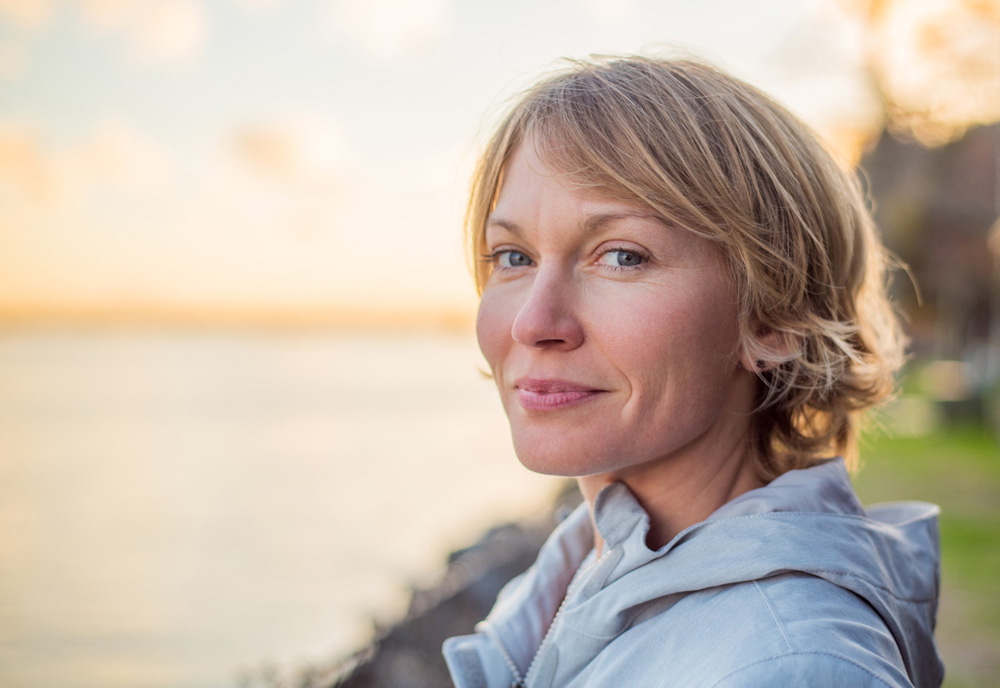- Patients
- Exploring cancer care
- Conditions we treat
- Breast cancer

Breast cancer
From first breast cancer symptoms through to advanced breast cancer, we offer world-class treatment. Find out more about breast cancer symptoms, causes, types and diagnosis.
Breast cancer treatment at GenesisCare
From first symptoms through to advanced (secondary) breast cancer, we offer world-class breast cancer treatment and care tailored to every patient.
We equip our centres with the latest technologies and offer many of the newest breast cancer tests, scans and treatments that are proven to be safe and effective, as standard. Our consultants are regional and national cancer experts who focus on you to achieve the best outcome possible and reduce the negative impact of treatment.
With us, you’ll receive the very best personalised care and a treatment plan that also embraces lifestyle-modifying approaches through our integrative cancer care programme, including exercise medicine and wellbeing therapies.
Call us today
What is breast cancer?
Breast cancer occurs when normal breast cells acquire mutations leading to uncontrolled growth, creating a tumour. It frequently starts in the cells that line the milk ducts (ductal cancer), but can also arise in breast lobes (lobular cancer).
Causes of breast cancer
You’re more at risk of getting breast cancer if you:
- Are older – your risk increases with age, around four in every eight cases occur in women over the age of 50
- Have a family history of breast or ovarian cancer – versions of the BRCA1 and BRCA2 genes can be passed on from parent to child and can increase your risk of developing breast cancer
- Have dense breast tissue
- Have exposure to hormones, through the contraceptive pill or hormone replacement therapy (HRT)
- Have a certain lifestyle – such as drinking alcohol on a regular basis, being overweight or obese
- Have previously had breast cancer or a lump
Can men get breast cancer?
Though most common in women, men can also develop breast cancer in rare cases, as it grows in the small amount of breast tissue behind a mans nipples.
The symptoms that both men and women should look out for are the same.
Breast cancer symptoms
If you get to know how your breasts normally look and feel, you’ll be more likely to spot any changes that could be signs of breast cancer.
What does breast cancer look like?
Compare one breast to the other and look out for:
- Thickening, rashes or colour changes in your skin or nipples such as redness if you have white skin, or darkening if you have brown or black skin
- Changes in breast size, shape or texture especially comparing one side to the other
- Swelling – a change in the contour of the breast
- Pain
- Changes to the shape or position of the nipples or a crustiness to the nipple and skin around it
- Discharge from the nipple that stains your bra/clothing without squeezing, especially if blood stained
If you're concerned about a lump or change in your breasts, it's important to get yourself checked as soon as possible to rule our anything serious that might need further investigation.
If you have a concern you should contact your doctor, or visit one of GenesisCare's one stop breast clinics where you can book an investigation, including mammogram, and discuss the findings with a senior breast surgeon on the same day.
How is breast cancer diagnosed?
Breast cancer can be detected using imaging, such as ultrasound, mammography or MRI, and biopsy to remove a small portion of tissue or fluid for further investigation.
One Stop Breast Clinic
At our One Stop Breast Clinics, you can get fast, direct access to an assessment with an expert breast consultant, a mammogram and a result on the same day.
What are the types of breast cancer?
Consultant Oncoplastic Breast Surgeon at GenesisCare, Prof PG Roy, explains the different types of breast cancer.
If you are found to have breast cancer, it could either be non-invasive or invasive.
Non-invasive breast cancer
About one in five women diagnosed with breast cancer through screening will have non-invasive breast cancer. This means there are cancer cells in the breast, but they’re only found inside the milk ducts and have not spread any further. This is also called ductal carcinoma in situ (DCIS). Sometimes the cancer cells stay inside the ducts, but they may also grow into the surrounding breast at a later date.
Invasive breast cancer
About four in five women diagnosed with breast cancer through screening will have invasive breast cancer. This is cancer that has grown out of the milk ducts and into the surrounding breast tissue. Most invasive breast cancers will spread to other parts of the body if left untreated.
Other types of invasive breast cancer include:
- Locally advanced breast cancer, where the cancer has spread to other areas nearby, such as the chest wall (including the skin and muscles of the chest) and lymph nodes
- Secondary (metastatic, advanced or stage 4) breast cancer, where cancer has spread to other parts of the body, such as the bones, liver or lungs
- Inflammatory breast cancer (where the skin is invaded by breast cancer cells) and Paget’s disease (where there are cancer cells on the nipple) which are less common
What is DCIS?
Ductal carcinoma in situ (DCIS) is the presence of pre-cancerous cells inside the milk ducts in one or both breasts. It is considered the earliest form of breast cancer and is sometimes referred to as Stage 0, or pre-invasive or non-invasive cancer. Cells that start to change, divide, and grow abnormally like this might eventually become an invasive breast cancer, but with DCIS that hasn’t happened yet. The abnormal cells have stayed inside the milk ducts and haven’t developed the ability to spread.
If left untreated, DCIS may (but not always) become invasive breast cancer, where it spreads outside the ducts.
However, usually DCIS doesn’t return or ever progress to a more invasive stage after it has been removed by surgery. So, finding and treating DCIS early almost always means a good outlook.
What is invasive breast cancer?
Early invasive breast cancer is primary breast cancer that has started in the breast and remains in the breast. It might have spread into the local lymph nodes around your breast, but not elsewhere in the body.
There are two main areas where breast cancer is found:
- In the milk ducts. This is where most breast cancer starts. This is called invasive ductal breast cancer
- In the lobes (the milk-producing glands). This is called invasive lobular breast cancer
When the origin of the cancer cells can’t be confirmed, it is termed NST – which means ‘no special type’. That means the cancer cells don’t have any particular features when viewed under a microscope.
Some early breast cancers spread to the lymph nodes, this is called locoregional early breast cancer.
It’s possible to have different breast cancers at the same time, for example invasive ductal and invasive lobular. It is very common for invasive ductal breast cancer to be found with ductal carcinoma in situ (DCIS) – which is a type of pre-cancer.
What is breast cancer metastasis?
Secondary breast cancer starts as a primary breast cancer in the breast. The cells develop the ability to move to other parts of the body (metastasise), usually through the lymphatic system (which fights infection) or blood. When they settle elsewhere, they start to grow there and become a secondary cancer.
Secondary cancer is also referred to as metastatic, advanced or stage 4 cancer.
The most common sites where secondary breast cancer spreads are:
- bones (skeleton)
- brain
- liver
- lung
Secondary breast cancer in the liver is not the same as primary liver cancer. The cancer cells started in the breast and spread to the liver so the treatments used are breast cancer therapies.
Sometimes a primary cancer that has been treated can return months or years later as secondary cancer.
Personalised breast cancer care
Find out more about our consultant-delivered breast cancer care and why we’re rated in the top 1% of healthcare providers worldwide for patient satisfaction.
Breast cancer stages
Your consultant will share your personal diagnosis with you and carefully explain the findings. They’ll tell you:
- The type of breast cancer you have
- The size of the tumour, or tumours if there is more than one
- The grade of your cancer – this is how fast it’s growing and scored on a scale of 1, 2 or 3
- Whether there is spread of breast cancer cells to the lymph nodes under your arm
This will be summarised using the TNM staging system. TNM stands for:
- T – the size of the tumour and any possible spread of the cancer
- N – the possible spread of the cancer to nearby lymph nodes
- M – the possible spread of the cancer to other parts of the body (metastasis)
Your consultant will also tell you the HER2 and oestrogen (ER) receptor status of your cancer cells. This will help decide your treatment.
What is HER2 positive cancer?
Some breast cancer cells have a protein on their surface called human epidermal growth factor receptor 2 (HER2). Some cancer cells make more of this protein than they should and use it to grow quickly and spread. These are called HER2 positive breast cancers. Approximately one in five invasive breast cancers is HER2 positive.
There are effective treatments available for HER2 positive breast cancers. These are often called targeted therapy, monoclonal antibody or biological therapies.
What is HER2 negative cancer?
Cancers that don’t produce more of this protein are called HER2 negative.
Triple negative breast cancers
It’s also possible to be both HER2 negative and ER and PgR negative. This is known as triple negative breast cancer (TNBC).
Patients with triple negative breast cancer don’t benefit from targeted or hormone therapies, but other treatments, including chemotherapy, are helpful.
Reviewed by:
Dr Russell Burcombe
UK Clinical Director of Breast Oncology
Consultant Clinical Oncologist
May 2023

Contact us today
We’re recognised by all private medical providers, including Bupa, AXA PPP, Aviva and Vitality. We’re always happy to answer any questions and concerns you may have.
Read next

Doctors
Our doctors
GenesisCare works with many leading and experienced cancer doctors who share our commitment to providing excellent patient care

Centres
Our centres
With 440 centres across the world, we're continuing to diagnose and treat without delay, bringing specialist care closer to our patients in the UK, Spain, Australia and the US.

Cancer care
Exploring cancer care
We are the UK’s leading private provider of advanced radiotherapy and cancer care. We offer fast access to the latest technology and treatments that has been proven to make a difference.

Cancer care
How can we help?
Accessing world-class cancer care is easier than you think. Follow these easy steps to get treatment, tests and scans, or a second opinion at GenesisCare, and find out the different ways of funding your cancer care.

Patient support
Patient stories
We believe patients can be our teachers and trusted advisers, benefiting from their unique experiences.